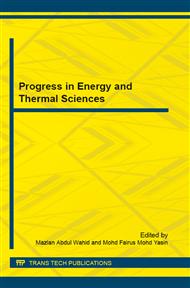[1]
Christie RD, Wollenberg BF, Wangensteen I. Transmission management in the deregulated environment. Proc IEEE 2000; 88: 170–95.
DOI: 10.1109/5.823997
Google Scholar
[2]
Kumar A, Srivastava SC, Singh SN. Congestion management in competitive power market: a bibliographical survey. Electr Power Syst Res 2005; 76: 153–64.
DOI: 10.1016/j.epsr.2005.05.001
Google Scholar
[3]
Acharya N, Mithulananthan N. Locating series FACTS devices for congestion management in deregulated electricity markets. Electr Power Syst Res 2007; 77: 352–60.
DOI: 10.1016/j.epsr.2006.03.016
Google Scholar
[4]
Besharat H, Taher SA. Congestion management by determining the optimal location of TCSC in deregulated power systems. Int J Electr Power Energy Syst 2008; 30: 563–8.
DOI: 10.1016/j.ijepes.2008.11.001
Google Scholar
[5]
Nguyen TT, Nguyen VL. Application of wide-area network of phasor measurements of secondary voltage control in power systems with FACTS controllers. In: Power engineering society general meeting, IEEE2005, vol. 3; 2005. p.2927–34.
DOI: 10.1109/pes.2005.1489418
Google Scholar
[6]
Rahimzadeh S, Tavakoli Bina M. Looking for optimal number and placement of FACTS devices to manage the transmission congestion. Energy Conver Manage 2011; 52: 437–46.
DOI: 10.1016/j.enconman.2010.07.019
Google Scholar
[7]
Singh SN, David AK. Optimal location of FACTS devices for congestion management. Electr Power Syst Res 2001; 58: 71–9.
Google Scholar
[8]
Ying X, Song YH, Chen-Ching L, Sun YZ. Available transfer capability enhancement using FACTS devices. IEEE Trans Power Syst 2003; 18: 305–12.
DOI: 10.1109/tpwrs.2002.807073
Google Scholar
[9]
Tuan LA, Bhattacharya K, Daalder J. Transmission congestion management in bilateral markets: an interruptible load auction solution. Electr Power Syst Res 2005; 74: 379–89.
DOI: 10.1016/j.epsr.2004.11.010
Google Scholar
[10]
Bompard E, Carpaneto E, Chicco G, Gross G. The role of load demand elasticity in congestion management and pricing. In: Power Engineering Society Summer Meeting, IEEE2000, vol. 4; 2000. p.2229–34.
DOI: 10.1109/pess.2000.867338
Google Scholar
[11]
Singh K, Padhy NP, Sharma J. Congestion management considering hydrothermal combined operation in a pool based electricity market. Int J Electr Power Energy Syst 2011; 33: 1513–9.
DOI: 10.1016/j.ijepes.2011.06.037
Google Scholar
[12]
Kirschen DS. Demand-side view of electricity markets. IEEE Trans Power Syst 2003; 18: 520–7.
DOI: 10.1109/tpwrs.2003.810692
Google Scholar
[13]
Strbac G. Demand side management: benefits and challenges. Energy Policy 2008; 36: 4419–26.
DOI: 10.1016/j.enpol.2008.09.030
Google Scholar
[14]
Albadi MH, El-Saadany EF. Demand response in electricity markets: an overview. In: Power engineering society general meeting, IEEE2007; 2007. P. 1–5.
DOI: 10.1109/pes.2007.385728
Google Scholar
[15]
Acharya N, Mithulananthan N. Influence of TCSC on congestion and spot price in electricity market with bilateral contract. Electr Power Syst Res2007; 77: 1010–8.
DOI: 10.1016/j.epsr.2006.08.026
Google Scholar
[16]
Le Anh T, Bhattacharya K. Competitive framework for procurement of interruptible load services. IEEE Trans Power Syst 2003; 18: 889–97.
DOI: 10.1109/tpwrs.2003.810998
Google Scholar
[17]
Fahrioglu M, Alvarado FL. Designing incentive compatible contracts for effective demand management. IEEE Trans Power Syst 2000; 15: 1255–60.
DOI: 10.1109/59.898098
Google Scholar
[18]
Aazami R, Aflaki K, Haghifam MR. A demand response based solution for LMP management in power markets. Int J Electr Power Energy Syst 2011; 33: 1125–32.
DOI: 10.1016/j.ijepes.2010.12.018
Google Scholar
[19]
Affonso CM. Silva LCPd. The potential benefits of implementing load management to improve power system security. Int J Electr Power Energy Syst 2010; 32: 704–10.
DOI: 10.1016/j.ijepes.2010.01.004
Google Scholar
[20]
Fu X, Wang X. Determination of load shedding to provide voltage stability. Int J Electr Power Energy Syst 2011; 33: 515–21.
Google Scholar
[21]
Sioshansi R, Short W. Evaluating the impacts of real-time pricing on the usage of wind generation. IEEE Trans Power Syst 2009; 24: 516–24.
DOI: 10.1109/tpwrs.2008.2012184
Google Scholar
[22]
Parvania M, Fotuhi-Firuzabad M. Demand response scheduling by stochastic SCUC. IEEE Trans Smart Grid 2010; 1: 89–98.
DOI: 10.1109/tsg.2010.2046430
Google Scholar
[23]
Shayesteh E, Yousefi A, Parsa Moghaddam M. A probabilistic risk-based approach for spinning reserve provision using day-ahead demand response program. Energy 2010; 35: 1908–15.
DOI: 10.1016/j.energy.2010.01.001
Google Scholar
[24]
Moura PS, de Almeida AT. Multi-objective optimization of a mixed renewable system with demand-side management. Renew Sust Energy Rev2010; 14: 1461–8.
DOI: 10.1016/j.rser.2010.01.004
Google Scholar
[25]
Billinton R, Lakhanpal D. Impacts of demand-side management on reliability cost/reliability worth analysis. In: IEE Proc – generation, transmission and distribution, vol. 143; 1996. p.225–31.
DOI: 10.1049/ip-gtd:19960190
Google Scholar
[26]
Bhattacharya K, Bollen MHJ, Daalder JE. Real time optimal interruptible tariff mechanism incorporating utility-customer interactions. IEEE Trans Power Syst 2000; 15: 700–6.
DOI: 10.1109/59.867162
Google Scholar
[27]
Horowitz I, Woo CK. Designing Pareto-superior demand-response rate options.
Google Scholar
[28]
Yusta JM, Khodr HM, Urdaneta AJ. Optimal pricing of default customers in electrical distribution systems: effect behavior performance of demand response models. Electr Power Syst Res 2007; 77: 548–58.
DOI: 10.1016/j.epsr.2006.05.001
Google Scholar
[29]
Roos JG, Lane IE. Industrial power demand response analysis for one-part realtime pricing. IEEE Trans Power Syst 1998; 13: 159–64.
DOI: 10.1109/59.651628
Google Scholar


